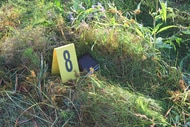Create a free profile to get unlimited access to exclusive videos, breaking news, sweepstakes, and more!
How Is Manner of Death Determined? A Forensic Pathologist Tells All
As new episodes of Accident, Suicide, or Murder return, Dr. Priya Banerjee M.D. says there's one "invaluable" way to glean how a person died, and it may not be what you think.
As the second half of Accident, Suicide, or Murder’s Season 5 draws closer, Oxygen.com sat with an expert to learn what helps postmortem examiners determine a manner of death.
Renowned board-certified forensic pathologist Priya Banerjee M.D., founder of the Rhode Island-based Anchor Forensic Pathology, said uncertainty over classifying a person’s manner of death as an accident, suicide, or homicide is a “rare question.” But “it’s not something I haven’t encountered,” Banerjee explained.
Such lines of inquiry serve as the focus for the well-trained and tenacious investigators featured in Accident, Suicide, or Murder, returning to Oxygen on November 16 at 8 p.m. and streaming on Peacock.
Do postmortem examiners work with police?
Dr. Banerjee, who practices in multiple states, said “a lot of communication” is involved between those conducting postmortem examinations and those tasked with finding a possible culprit. As the former Medical Examiner in Rhode Island, she occasionally provided her expertise at crime scenes, but only when directly investigating the physical body.
Otherwise, crime scene investigators provided what they had.
“A death is reported, and there’s a history given [by authorities],” Banerjee told Oxygen.com. “Whatever’s known at the time, but that’s also very preliminary.”
Part of Dr. Banerjee’s career consisted of training resident or junior doctors aspiring to become pathologists. She'd often tell them, “Sometimes you get to trust your gut” if their findings about a person’s death didn’t match what was in the preliminary report. Still, keeping the investigators’ notes in the back of their minds was always crucial.
“Because the story changes,” she said. “By the time the investigation continues, X, Y, Z, it may be a totally different understanding. Because the police hadn’t done all their stuff either.”
Take, for example, the purported slip-and-fall death of wealthy New York philanthropist Leslie Neulander, just one case featured on Accident, Suicide, or Murder. Her 2012 passing was initially believed to be an accident until friend and retired medical examiner Dr. Mary Jumbelic looked into her friend’s death and found Neulander’s injuries were more consistent with defense wounds than a fall.
Financial turmoil, infidelity, and a history of violence would all be factors when amending the woman’s manner of death to homicide and, ultimately, convicting her husband of murder.
“Let’s say there’s something weird I find,” Dr. Banerjee told Oxygen.com. “I treat it [as] suspicious.”
Evidence found on the body is sealed and signed off by pathologists, handed over to law enforcement, and becomes part of the chain of custody.
How do medical examiners determine if a death is suspicious?
Of course, there are more straightforward examples in which the cause of death doesn’t require as much work, such as when a person has suffered a fatal heart attack. Experts like Dr. Banerjee must work with what they have, especially in more complex situations. When suspicions arise, they perform “extensive workups,” often including DNA, toxicology, and other means of modern technology.
“If it’s nebulous, we always treat it as suspicious,” she maintained.
Keeping fingernails would also be common, but X-rays have been vital in helping determine how someone died.
“X-rays are such an invaluable tool for us to see what’s going on in the body before we even open it up,” Banerjee said. “It will always show if there’s bullets or a knife tip or something. You may be able to gather broken bones.”
But X-rays aren’t only good for finding details supporting a violent means of death; they could also detect disease. Fluid in the lungs, for instance, could point to pneumonia, or an enlarged heart could point to a myriad of physical conditions.
How the Deceased's History Factors Into Determining Cause of Death
Citing the recent October 16, 2024 death of One Direction singer Liam Payne, 31, (whose manner and cause of death had yet to be released at the time of this Oxygen interview), Dr. Banerjee said a person’s history would also help pathologists determine a manner of death.
“The injuries are going to be the same,” no matter the manner of death, she explained.
Payne fell from a Buenos Aires hotel balcony which, according to the Argentina National Prosecutor’s Office, resulted in his death, according to an Oct. 22, 2024, report from NBC News. Preliminary toxicology reports stated the former teen idol had a plethora of recreational drugs in his system, though a manner of death had yet to be determined.
Investigating crime scene officials could access evidence that people like Dr. Banerjee could not, such as obtaining surveillance photos, interviewing witnesses, or reviewing the decedent’s message history. But, she said, a person’s medical or psychiatric history could “paint a better picture,” Banerjee told Oxygen.com.
“I’m one of those [people] that my investigators hate because I ask for everything,” Banerjee joked.
A person’s history of substance abuse or illicit drugs found at the scene could point to a drug-related death, though a toxicology report would confirm or deny suspicions. A previous diagnosis of a mental illness could point to suicide.
Dr. Banerjee gave an example: “If suicide comes into play, I always want to know if they have a psychiatric history and if it’s diagnosed,” she said. “Let’s say it’s a clear-cut suicide. Hanging, no question. But I would still put ‘clinical history of depression or anxiety’ as a diagnosis … I would say, ‘I didn’t make that up.’”
What happens if you can’t rule accident, suicide, or murder?
Professionals tasked with performing autopsies have five options to choose from when it comes to manner of death: Accident, Suicide, Homicide, Natural Causes, and Undetermined.
Dr. Banerjee said when she couldn’t “pigeonhole” a person’s death to fit into any of the first four, she would mark it “Undetermined.” She clarified that manner of death was a medical ruling — not a legal ruling — in which case, law enforcement could still pursue their own investigation.
One instance could include a man who died after his car hit a tree at 90 m.p.h., and therefore, his manner of death is ruled “accidental.” However, if the police were to discover later down the line that the vehicle’s brake lines had been cut by his scorned ex-wife, the report could be amended, and death could be ruled “homicide.”
“It can even become a cold case type of thing,” Banerjee told Oxygen.com. “The ‘Undetermined’ doesn’t mean ‘I don’t know, I give up.’ It just means, ‘I can’t better channel it, but you guys can still work on it,’ and if there’s new information, we can always revisit it.”
Some of the most recent cases featured in Accident, Suicide, or Murder in which the manner of death had been changed included the on-campus death of Florida college student Jennifer Kairis, the 2002 car crash of Deborah Hollermann, and the poisoned victims of Missouri respiratory therapist Jennifer Hall.
See more in all-new episodes of Accident, Suicide, or Murder, airing Saturdays at 8/7c on Oxygen and streaming the next day on Peacock.




































